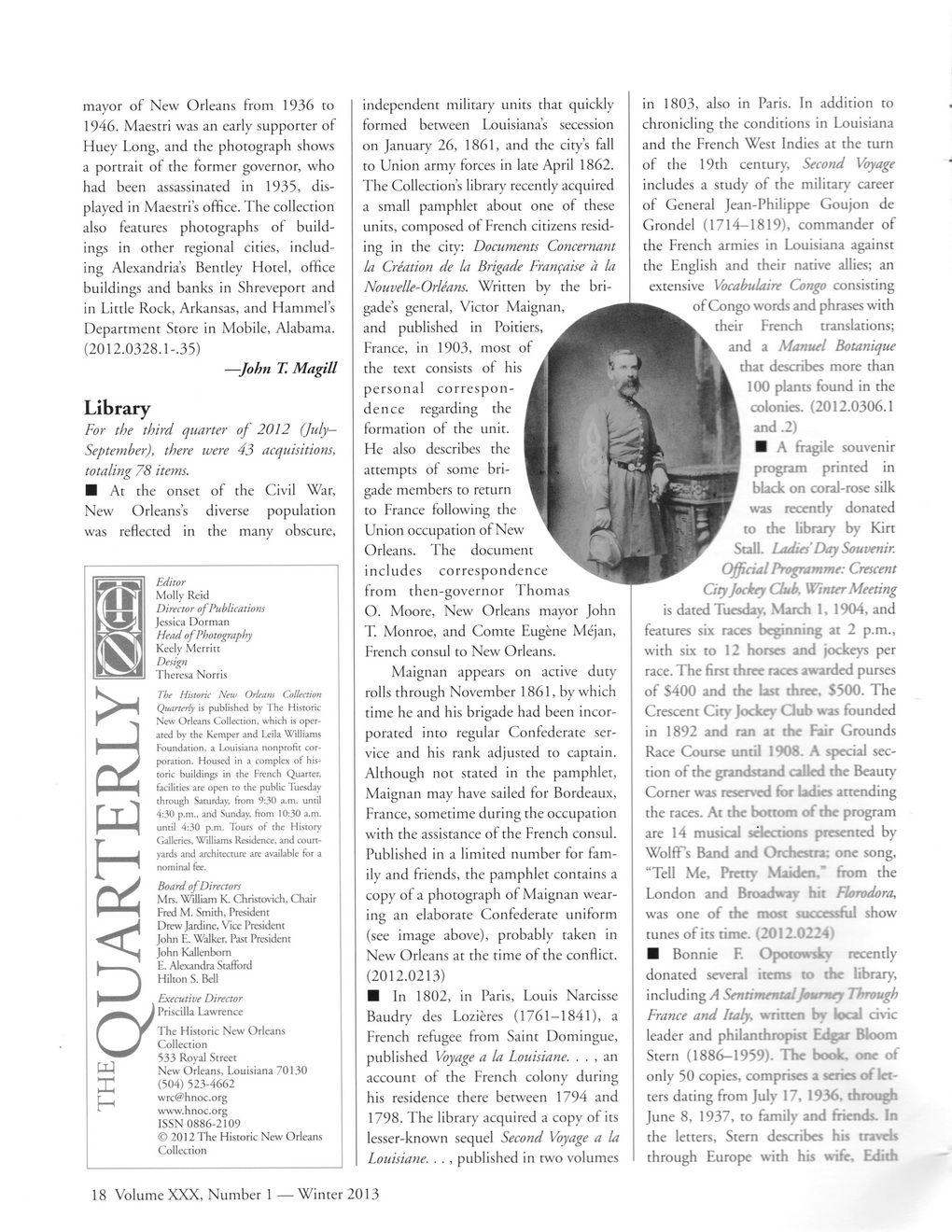This text was obtained via automated optical character recognition.
It has not been edited and may therefore contain several errors.
mayor of New Orleans from 1936 to 1946. Maestri was an early supporter of Huey Long, and the photograph shows a portrait of the former governor, who had been assassinated in 1935, displayed in Maestri’s office. The collection also features photographs of buildings in other regional cities, including Alexandria’s Bentley Hotel, office buildings and banks in Shreveport and in Little Rock, Arkansas, and Hammel’s Department Store in Mobile, Alabama. (2012.0328.1-.35) —John T. Magill Library For the third quarter of 2012 (July— September), there were 43 acquisitions, totaling 78 items. ■ At the onset of the Civil War, New Orleans’s diverse population was reflected in the many obscure, Editor Molly Reid Director of Publications Jessica Dorman Head of Photography Keely Merritt Design Theresa Norris The Historic New Orleans Collection Quarterly is published by The Historic New Orleans Collection, which is operated by the Kemper and Leila Williams Foundation, a Louisiana nonprofit corporation. Housed in a complex of historic buildings in the French Quarter, facilities are open to the public Tuesday through Saturday, from 9:30 a.m. until 4:30 p.m., and Sunday, from 10:30 a.m. until 4:30 p.m. Tours of the History Galleries, Williams Residence, and courtyards and architecture are available for a nominal fee. Board of Directors Mrs. William K. Christovich, Chair Fred M. Smith, President Drew Jardine, Vice President John E. Walker, Past President John Kallenbom E. Alexandra Stafford Hilton S. Bell Executive Director Priscilla Lawrence The Historic New Orleans Collection 533 Royal Street New Orleans, Louisiana 70130 (504) 523-4662 wrc@hnoc.org www.hnoc.org ISSN 0886-2109 © 2012 The Historic New Orleans Collection independent military units that quickly formed between Louisiana’s secession on January 26, 1861, and the city’s fall to Union army forces in late April 1862. The Collection’s library recently acquired a small pamphlet about one of these units, composed of French citizens residing in the city: Documents Concemant la Creation de la Brigade Frangaise a la Nouvelle-Orleans. Written by the brigade’s general, Victor Maignan, and published in Poitiers, France, in 1903, most of the text consists of his personal correspondence regarding the formation of the unit. He also describes the attempts of some brigade members to return to France following the Union occupation of New Orleans. The document includes correspondence from then-governor Thomas O. Moore, New Orleans mayor John T. Monroe, and Comte Eugene Mejan, French consul to New Orleans. Maignan appears on active duty rolls through November 1861, by which time he and his brigade had been incorporated into regular Confederate service and his rank adjusted to captain. Although not stated in the pamphlet, Maignan may have sailed for Bordeaux, France, sometime during the occupation with the assistance of the French consul. Published in a limited number for family and friends, the pamphlet contains a copy of a photograph of Maignan wearing an elaborate Confederate uniform (see image above), probably taken in New Orleans at the time of the conflict. (2012.0213) ■ In 1802, in Paris, Louis Narcisse Baudry des Lozieres (1761-1841), a French refugee from Saint Domingue, published Voyage a la Louisiane. . . , an account of the French colony during his residence there between 1794 and 1798. The library acquired a copy of its lesser-known sequel Second Voyage a la Louisiane. . . , published in two volumes in 1803, also in Paris. In addition to chronicling the conditions in Louisiana and the French West Indies at the turn of the 19th century, Second Voyage includes a study of the military career of General Jean-Philippe Goujon de Grondel (1714-1819), commander of the French armies in Louisiana against the English and their native allies; an extensive Vocabulaire Congo consisting of Congo words and phrases with their French translations; and a Manuel Botanique that describes more than 100 plants found in the colonies. (2012.0306.1 and .2) ■ A fragile souvenir program printed in black on coral-rose silk was recently donated to the library by Kirt Stall. Ladies Day Souvenir. Official Programme: Crescent City Jockey Club, Winter Meeting is dated Tuesday, Mardi 1, 1904, and features six races beginning at 2 p.m., with six to 12 horses and jockeys per race. The first three races awarded purses of $400 and the Last three, $500. The Crescent City Jockey Qub was founded in 1892 and ran at the Fair Grounds Race Course until 1908. A special section of the grandstand called the Beauty Corner was reserved for ladies anending the races. At the bottom of the program are 14 musical selections presented by WolfFs Band and Orchestra; one song, “Tell Me, Pretty Maiden,’ from the London and Broadway hit Florodora, was one of the most successful show tunes of its time. (2012.0224j ■ Bonnie F. Opow_ JLy recently donated several items to the library, including A SentimenudJsnmcy Through France and Italy, written by local civic leader and philanthropist Edgar Bloom Stern (1886-1959). The book, one of only 50 copies, comprises a series of letters dating from July 17, 1936, through June 8, 1937, to family and friends. In the letters, Stern describes his travels through Europe with his wife, Edith 18 Volume XXX, Number 1 —Winter 2013

New Orleans Quarterly 2013 Winter (18)